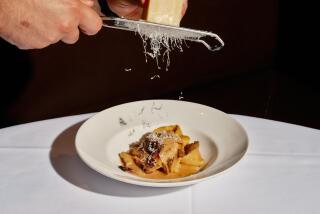Italian Markets for Hard-to-Find Pasta
Question: Please help me find a source for a product called orzo. It is described as a rice-shaped pasta. I have a couple recipes Iâd like to try it in.
Answer: Some specialty grocery stores carry orzo, but a sure source is an Italian market. Two that immediately come to mind are Sorrento Market in Culver City and Bay Cities Importing in Santa Monica. Perhaps the local telephone directory will list others.
Q: A while back I read about an herb beverage called Norfolk Punch but have been unable to find it. Do you have any information?
A: The product is just beginning to be distributed in the Los Angeles area. You should be able to find it in Mrs. Goochâs Natural Foods Ranch Markets and at selected Broadway department stores.
For those unfamiliar with Norfolk Punch, the imported, non-alcoholic drink is produced at Welle Manor Hall in Norfolk, England. Itâs made from an original 13th-Century recipe developed by Benedictine monks.
The beverage contains more than 30 herbs and spices, is ruby red in color and may be served hot or cold. No claims are made regarding the medicinal benefits; but according to historical records, the Monks prescribed it for everything from insomnia to upset stomachs.
Q: My grandmother recently gave me a cookbook published in Canada in 1932. Many of the bread recipes the book contains call for a cup of âplain bread sponge.â What exactly is bread sponge and can I substitute something in my recipes?
A: The book could be referring to a form of starter, the âmixture of flour and liquid into which bacteria, wild or otherwise, is introducedâ, as defined by Bernard Clayton Jr. in âThe Complete Book of Breadsâ (Simon and Schuster: 1973).
Clayton goes on to write: âThe next step is adding more flour and liquid to make a sponge that is essentially a larger bowl of starter. Now about half of the flour and liquid is fermenting, and the yeast cells are multiplying by the millions. The final step--the sponge becomes the dough.â
There is also a variation of the convention method of making bread called the sponge method. âFarm Journalâs Homemade Breadsâ (Doubleday: 1985) explains: âThough itâs not used as frequently today as it was in the past, the sponge method is still a viable way to make yeast bread.
âIn the sponge method, yeast is dissolved in warm water. Sugar, liquid and part of the flour are stirred into the dissolved yeast. It is then allowed to rise forming an airy, foamy mixture that resembles a sponge. The sponge is then stirred down and the remaining ingredients are added before kneading.â
With this information and a little experimentation, you may be able to successfully prepare the recipes.
Q: I have read that you can use egg substitute in most entrees, some pastries and cakes. But how does it work in custard, puddings and ice cream? I guess the question is, when can egg substitute be used?
A: According to Avoset Food Corp., manufacturers of Second Nature egg substitute, their product may be used in any recipe calling for whole beaten eggs. They do not recommend using the product raw; it should always be cooked.
Address questions on food preparation to You Asked About . . ., Food Section, The Times, Times Mirror Square, Los Angeles 90053. Personal replies cannot be given.
More to Read
Eat your way across L.A.
Get our weekly Tasting Notes newsletter for reviews, news and more.
You may occasionally receive promotional content from the Los Angeles Times.







